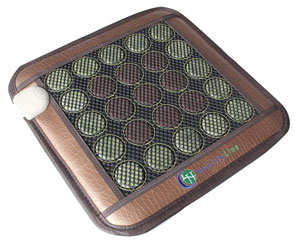The term “pinched nerve” is most likely something you’ve heard after experiencing pain in your back. When that back pain doesn’t go away on its own through normal rest, your doctor will often diagnose it as a pinched nerve in the back.
Most often, a pinched nerve is the result of a degenerative spinal condition but can sometimes be the result of an acute injury. Once the location of the nerve pain is diagnosed (sometimes not so simple), you’ll want to start treatment as soon as possible.
Causes Of A Pinched Nerve in the Back
A pinched nerve is the result of too much pressure being put on the nerve root from surrounding bone or tissue. This leads to pain and even numbness to the area of the pinch or any of the areas of the body which that nerve root goes through.
Related:
 While bone pinching the nerve is often the culprit, this can actually be due to severe muscle tightness which causes parts of your body to become unaligned.
While bone pinching the nerve is often the culprit, this can actually be due to severe muscle tightness which causes parts of your body to become unaligned.
For example, if you have a severely tight hamstring muscle, this can cause one side of your body to drop slightly lower than the other (due to the tighter/shorter hamstring muscle). This in turn can shift parts of your vertebrae which causes the pinched nerve. This is what makes nerve pain so hard to diagnose sometimes.
The three main causes of pinched nerves in the back are:
- Herniated discs (or ruptured or bulging)
- Bone spurs
- Spinal stenosis
Pinched Nerve Symptoms
As mentioned above, pain and numbness are two symptoms of a pinched nerve. However, there are other things that may be associated with this type of injury as well. A sharp stabbing pain or burning pain is something that some people report with their pinched nerve.
It’s not uncommon for a severe pinched nerve in the lower back to cause a sharp, shooting pain all the way down to your toes.
The feeling that the area of the pinched nerve has “fallen asleep” is another complaint of some who have a pinched nerve. Finally, weakness in the area of the pinched nerve may be another symptom that one has to deal with.
At-Home Treatment Options
Many of us would like the quickest and least expensive option to rid ourselves of the pain. Treatment at home is a good option for those who are determined and diligent enough to take care of the issue on their own.
There are a few ways to treat this type of pain without having to leave home. Of course if the pain is severe enough or you don’t feel comfortable trying on your own, go see a professional such as your doctor, chiropractor, or physical therapist.
Posture Adjustment
Do you spend a lot of time thinking about how you sit or stand on a daily basis? The answer is probably not. We often fall into poor posture habits such as slumping or not sitting straight. A certain position may feel more comfortable to us in the moment, but it can cause some serious damage to our backs over the long term.
For those of use with desk jobs where you’re sitting all day, it’s critical to ask for or invest in a good office chair for your back or at the very least, a chair cushion to support your back.
You also need to make sure you are sitting with your back straight and not in unnatural sitting positions such as when you use multiple areas of your desk. Always take time at regular intervals to stand up and move around throughout the day
Standing Desk
 The standing desk is a very popular trend these days. That’s because the standing desk can have certain health benefits that a sitting desk does not. We spend way too much of our time these days sitting down. A standing desk is a good option but an adjustable sit/stand desk is the best of both worlds to allow you to alternate you’re working position.
The standing desk is a very popular trend these days. That’s because the standing desk can have certain health benefits that a sitting desk does not. We spend way too much of our time these days sitting down. A standing desk is a good option but an adjustable sit/stand desk is the best of both worlds to allow you to alternate you’re working position.
That said, standing desks are definitely not the solution for everyone. Often, standing in place is one of the worst positions you can be in for certain pinched nerve issues. If it makes the pain worse, don’t do it. Something that may help is investing in a pair of shoes specifically for back pain to give you the cushioning and support you need.
Inversion Table
Because a pinched nerve in the back is often the result of two vertebrae in your spine being too close to each other (compressed), decompression therapy is often helpful. This is usually done via inversion therapy and can easily be done in the comfort of your own home. Be sure to check out our inversion table reviews to see what’s worth buying and what to avoid.
Stretches
Because tight muscles are often the underlying cause of a pinched nerve in the spine, there are certain stretches you can do that can almost immediately relieve the majority of the pain. If you’re diligent about stretching every day, your pain can gradually decrease over time and ultimately leave altogether. This is why physical therapists are often the first course of action for any type of nerve pain.
Here is one of my absolute favorite and most effective stretching routines for lower back pain due to a pinched nerve. It literally takes only 15 minutes a day.
Heat or Ice
 Applying heat or ice to the area of your body that is hurting can provide some relief. Ice is known to provide the numbing effect that takes away some of the pain temporarily while heat loosens up some of the tight muscles. It’s a quick way to temporarily get some relief.
Applying heat or ice to the area of your body that is hurting can provide some relief. Ice is known to provide the numbing effect that takes away some of the pain temporarily while heat loosens up some of the tight muscles. It’s a quick way to temporarily get some relief.
Having a good heating pad on hand can go a long way and the infrared type are the best as they penetrate deeper into the tissue. Alternatively, a hot bath can offer some temporary relief.
For ice, you’ll want to get yourself a good size gel ice pack (I recommend this one), but you can also simply put some ice from your freezer into a Ziplock bag.
If Home Remedies Don’t Work For You
Home remedies are not for everyone. If you find the at-home treatment options don’t help as much as you hoped or actually make things worse, you should seek professional care. In these cases, your best bet is to see your doctor. They can best work with you on the next step whether it be referring you to a chiropractor, physical therapist, or other professional.
Adam
Latest posts by Adam (see all)
- Running and Lower Back Pain (Before, During, and After Running) - July 1, 2019
- Benefits of Swimming Pool Exercises for Back Pain - March 20, 2019
- Care Options for Seniors With Back Pain - September 4, 2018


Great video, very informative. My husband has had a spinal fusion, he will try some of them. Thank you